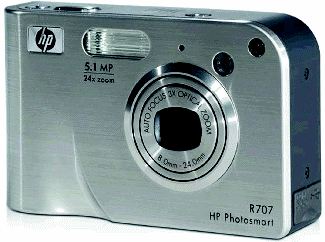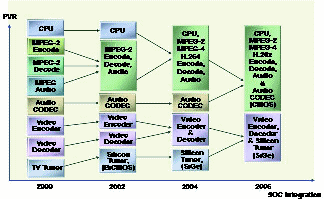Customizable Convergent Portable Devices Are Coming
System-on-chip technology will revolutionize portable-equipment design. Even display and interface design will depend on the capabilities of SoC integration as portable products become more and more multifunctional.
by Gene A. Frantz
NOT A DAY GOES BY that we do not envy our colleagues in the large-screen-TV market. Regardless of which new display technologies they are developing – be it DLP, plasma, LED, LCD, or some next-generation technology – the real estate is always expanding and the devices are never more than 6 ft. away from an AC receptacle. At the portable end of the market, we, too, are making a similar drive toward better display capabilities, but we have to deal with two rather mind-boggling constraints. First, we have to work within the confines of a package that seems to grow smaller by the day. Second, we have to make it all work with a battery that is getting smaller and smaller.
But that is yesterday's news. Today's news is that we have to do all that and more. Our customers expect multifunctional portable equipment. They want us to put traditionally distinct, but converging, technologies into a single portable device.
Cellular telephones are the most obvious example. They already incorporate personal-digital-assistant (PDA) features, contain global-positioning-system (GPS) functions, and take still photos and video clips. Soon, we will see a quantum leap in still-photo quality and an even bigger leap in video quality. Convergence will shift into high gear as the new models incorporate Wireless LAN (WLAN) and Voice over Internet Protocol (VoIP). Not to be left out of the convergence race, digital still cameras (DSCs) will see similar improvements in both still-photo and video quality, as well as the addition of in-camera editing and WLAN (Fig. 1). That is a great deal of processing going on in one small package.
 Hewlett-Packard Co.
Hewlett-Packard Co.
Fig. 1: Digital still cameras, such as this Hewlett-Packard Photosmart R707, are wonders of mechanical and electronic miniaturization, but there is much more to come. We will soon see substantial improvements in both still-photo and video quality, as well as the addition of in-camera editing and wireless LAN connectivity.
The Goal of Single-Chip Integration
It was not too long ago that the average DSC rapidly exhausted a set of batteries. Discrete system-on-chip (SoC) integration has changed that equation. By integrating certain feature processing functions into discrete chipsets, we have seen a monumental increase in performance with a decrease in power consumption.
Consider the digital video camera. It must not only encode and decode audio and video, but to conserve storage space it must also compress and decompress the data. In 2000, the typical digital camcorder required eight separate chips to perform these functions: CPU, MPEG-2 encode, MPEG-2 decode, audio encode, audio decode, video encode, video decode, and TV tuner. By 2004, SoC integration had allowed us to reduce the number of chips to four while still allowing us to add the newer and far more efficient MPEG-4 and H.264 compression schemes (Fig. 2). We also incorporated the CPU into the chipset, resulting in reduced bus traffic and reduced real estate. From 2000 to 2004, consumers responded positively to the new models, and digital-camcorder sales soared.
The digital-camcorder example gives us a bit of perspective on what chip integration can accomplish within the bounds of a single technology. Converging technologies in a single device, on the other hand, has presented us with special challenges.
To convert RF signals to digital, the transistor performance (Ft) – the frequency at which the gain of the transistor is equal to 1 – must be roughly ten times the analog frequency range, meaning we need an Ft of at least 24 GHz. Until recently, it was very difficult to provide such high performance in a digital process. But advances in IC processing have changed the picture. For example, the 90-nM technology has an Ft on the order of 100 GHz at an affordable price.
We expect that the use of a discrete SoC will increase as we pack more and more converging technologies into a single portable device. Discrete SoC is allowing the concepts of SoC technology to apply to multiple chips in a system design. When further integration is possible, the drive to a single chip is relatively simple. That, in turn, will free up power to run the newer displays.
How Small Is Too Small?
Beyond the fact that color displays are becoming the de facto standard for all portable equipment, nothing else concerning displays for portable devices is certain. Resolution, substrate materials, and which display type (emissive, reflective, or backlit) will dominate the market are all undecided. And there is a more-important fundamental question we must answer first: In a portable interactive device that features state-of-the-art graphics capabilities, how small is too small?
At the extreme end, some cellular telephones have already gone beyond what can reasonably be called "handheld"; some models should probably be called "fingertip" phones. Voice command partially compensates for their minuscule keyboard size; and where voice does not work, the user can revert to stylus or fingernail dialing. Unfortunately, the screens on these small devices are practically unreadable. They may work for alphanumeric information, but they are simply too small for viewing high-quality color graphics. Add an entire baby-boomer generation with presbyopia to the mix and, unless we are talking about projection or microdisplays, these small devices are not user-friendly.
On the PDA front, we have the opposite dilemma. We have a screen size that is perfect for high-quality graphics, but it comes at the expense of the entire keyboard. Using the stylus as the sole input device may be acceptable to first adopters, but is it going over well with mass-market consumers? Of course, these users can add a foldable auxiliary keyboard, but that stretches the definition of "pocket-sized portable."
Since the average size of the human hand and the size of pockets in clothing are unlikely to change any time soon, optimum display size for mass-market high-quality-graphics displays may have to fall somewhere between the extremes of full-screen PDAs and inconveniently small fingertip telephones.

Fig. 2: Due to system-on-chip (SoC) integration, a typical digital camcorder that in the year 2000 required eight separate chips to encode and decode audio and video, and to compress and decompress the data, now requires only four – and those chips now incorporate the CPU and the far-more-efficient MPEG-4 and H.264 compression schemes.
The Next Generation
The entire size argument is based on the premise that we will continue to build self-contained multifunctional, portable devices that either fit in a pocket or clip on to our clothing. But with integrated WLAN capabilities already on the horizon, we owe it to ourselves to consider separating the display from the device itself. That next-generation technology will most likely include some type of near-to-eye (NTE) high-resolution micro-display that runs wirelessly from a wearable digital processor.
Current microdisplay technologies include liquid-crystal on silicon (LCoS) and organic light-emitting-diode on silicon (OLEDoS). LCoS displays offer low cost, but because the technology is not emissive, it requires additional illumination, obviating some of the price advantage and adding to overall power consumption. OLEDoS technology, because it is an electroluminescent technology, provides its own light. It also maintains high brightness levels at all forward viewing angles.
All NTE microdisplays require some type of head-mounted device (HMD) in the form of eyeglasses, goggles, visor, or a headband (unless the display is held up to the eye by hand). While an HMD may appear at first glance to be an impediment to mass-market appeal, it may prove to be no more dis-advantageous than an unreadable display on a fingertip-sized device.
The ultimate solution to the display issue is obvious. It will come when we remove all the I/O functions from the device and relocate them in the human brain. That is not as far-fetched as we might think. Cochlear implants are a perfect example. A hearing aid magnetically transmits digital data through the skin to the implant, where it is converted back to electrical signals and connected to nerve endings. Similar advances are being made with visual equivalents. SoC technology will be part of that solution. But not yet – such a device has not yet seen the light of day.
The Consumer's Breaking Point
We are not sure whether technology is driving the move towards convergence or whether we are simply responding to market demand and expectations. But this much we are sure of: The mass market wants better cameras, better video, VoIP, and WLAN, and they are running out of pockets. So it only makes sense to build convergent multifunctional devices.
But there are also conflicting signals in the convergence mix. Consumers with home-theater systems probably have a dozen remote controls cluttering up their coffee tables. The behind-the-scenes wiring matrix most likely includes five miles of cable, takes up every available outlet (plus additional power strips), and may even dim the lights when the power switch is flipped on. The owners of such home theaters are theoretically ripe for a convergent system.
A convergent unit would eliminate all the wiring problems and simplify programming. But how many of these consumers would seriously consider buying a TV/PC/WLAN/cable-modem/Webcam/DVD/CD/VCR with surround sound, and one remote that runs the whole thing? There would not be many takers, but why is that? Consumers like choices, and in this scenario the choices are just too limited.
But these same consumers gladly risk being totally out of commission if their cellular-telephone/PDA/camera breaks. In fact, many wireless users upgrade to newer models without experiencing a phone failure. The challenge in the convergence game will be to find the consumer's breaking point. As is the case with the size question, we must all discover how much convergence is too much.
Customizing Portable Devices
In just a few decades, we have gone from a world in which thousands of users shared a single mainframe to one in which our relationship with our computer is one-on-one. We have also become highly dependent on it to conduct our personal affairs. Ask to use someone's desktop computer and the permission will come with the caveat, "Don't change any of my settings." Ask to use their PDA and one will probably get rejected outright. We are entering an era when consumers are using their electronics as an extension of who they are. Whether it is a special screen saver, a unique ring tone, or special start-up and shut-down tunes, their "settings" are becoming a personal statement.
This new twist to consumer electronics holds vast implications for chipset designers. For example, future market research may show that when it comes to convergent portable electronics, consumers want a telephone/camera/PDA combination. But the first company to produce a customizable combination of different technologies in a single device will turn the entire market on its head. Fortunes could be made or lost simply on the availability of customizable options. This is an area in which SoC technology offers incredible potential.
As SoC capabilities expand and costs go down, equipment manufacturers could find themselves in the unique position of building products with dozens of convergent technologies on a single chip. Each technology could be turned on at the time of sale, depending on consumer preferences and budget. So far our discussion has emphasized cellular telephones and digital cameras, but SoC developments on this scale could integrate consumer, medical, and industrial technologies into a single device. The possibilities are truly endless.
The next few years will be critical for the portable-equipment industry. Display technologies will begin to shake out, convergence will take hold, and demand for our products will skyrocket. •
Gene A. Frantz, TI Principal Fellow, is Business Development Manager of Texas Instruments' Digital Signal Processing Semiconductor Group; e-mail: genf@ti.com.